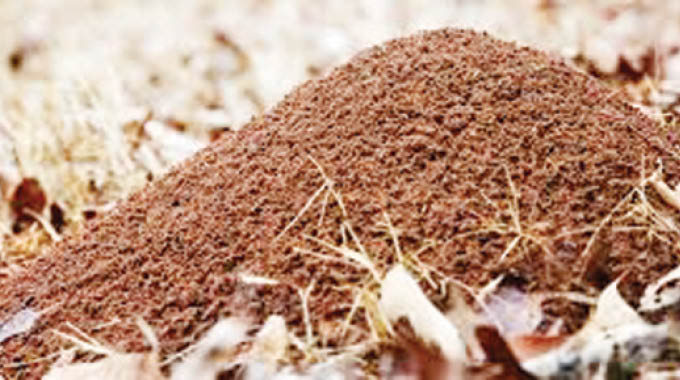Input prices derail cropping season preparations

Elliott Siamonga
Tyson Mzamba is a well-known farmer in Gwangwaliba Village in Binga.
He grows mainly sorghum, rapoko, groundnuts and maize. Over the years he has produced surplus to sell to the Grain Marketing Board (GMB).
However, his preparations for this year’s cropping season are being hampered by the high prices for inputs such as chemicals, fertiliser and seed.
Short of fertiliser, Mzamba and fellow communal farmers have turned to more basic alternatives — anthills, leaf humus and cattle manure — to boost the fertility of their yields.
They are digging up the biggest anthills found in local forests although he says the earthly mounds are regarded as sacred by some traditionalists in his community. After digging up the anthills, they crush the soil, sift it and then cart it to their fields by oxdrawn carts or wheel barrows.
The sifting is done so as to separate the nutrient rich soil from objects such as discarded enamelware, bones, broken bottles and earthen ware.
“This is back-breaking work, but I have no choice as the heavens will open up soon so I have to be prepared,” Mzamba said.
“I have dug up five anthills so far and have found coloured beads, old black and red clothes, bones and sometimes animal skins. These are sacrifices. I just sift the soil and bury them back.
“It is scary because you don’t know what these items are for and the bones, one cannot be sure whether they are human or animal, but what can I do? I have to maintain good yields and fertiliser prices have gone up.”
Prices of fertiliser and other farming inputs have gone up sharply in recent weeks. A 50 kg bag of Compound D fertiliser costs between $400 and $450 while the price of a 10 kg bag of seed maize is being sold for around $300. Most communal farmers say they cannot afford the prices of fertiliser hence they have turned to traditional ways of manuring their fields.
However, traditional healers and elders contend that the digging up of anthills is defiling the environment and their cultural beliefs. They say that some anthills are sacred places reserved for “communication with our ancestors” or are simply burial places.
“I think digging up these anthills is not good as the mounds are sacred. Where are we going to bury our dead or communicate with our ancestors?” said Arron Siamchali (80).
Heritage and environmental officials say anthills played an important role in the ecosystem.
“Ants play a role in the ecosystem and the destruction of their habitats will disrupt the whole ecosystem that may have an effect on the very farmers who are digging up these anthills,” said environment consultant, Claire Wood.
Often seen in the barren landscapes of savanna grasslands and forests, the earthly mounds can be up to four metres high and five metres wide. They are home to a variety of animals, insects, reptiles and their host the termites which can burrow up to 10 metres under the anthills where their queen lives.
When farmers mix the anthill soil with top soil during land preparation, it acts just like the fertiliser improving the soil texture and clay content.
A number of studies have been carried out on the efficacy of the use of anthill soil as an alternative of conventional fertilisers. The studies have established that a number of factors prompt smallholder farmers to use anthills but the biggest one was their limited resources to be able buy mineral fertilisers.
A research, “Socio-Economic Factors for Anthill Soil Utilisation by Smallholder Farmers in Zambia,” whose findings were published in September asserts the benefits that farmers derive from using anthill soils to enrich their fields. It says the building of anthills is done by anthill-building ants assembling woody debris for their nests and forage, which is utilised as food for colonies. As a result anthills are supplied with soil organic matter and inorganic nutrient elements, consisting of calcium, magnesium and sodium in comparison with adjacent soils. In addition, bioturbation activities potentially contribute to changing soil physical characteristics such as porosity and infiltration, soil micro-organisms and resulting fauna biomass and faster decomposition of organic matter.
“Scholars have all linked soil physical-chemical characteristics of anthill soil to the building activities of ants which makes anthill soils more fertile with key nutrient elements needed for crop production in comparison with surrounding soils,” the study says.
“Additionally, farmers have also indicated that once the anthill soils are applied in their agriculture lands, fertiliser application may not be required for at least three years.
The smallholder farmers perceived that more benefits were expected with the use of anthill soils and planting legume crops such as cowpeas, beans and groundnuts.
Additionally, the smallholder farmers indicated that with the use of anthill soil in agriculture production, benefits were more comparable with conventional soil fertility management practices, as the resource was easy to access.”
An earlier study, “The Potential of Anthill Soils in Agriculture Production in Africa: A review,” published by the International Network for Natural Sciences in November 2017 recommends that for effective utilisation of anthills in crop production, there is need to build the capacity of extension staff and farmers on the application method using micro dosing techniques and simple estimation of quantity for determining the requirements per hectare.
Therefore, the back-breaking work that Mzamba and his colleagues do has scientifically- proven benefits.
“We are still waiting for inputs but meanwhile we have to do what we can, get alternative manure,” he said.











Comments